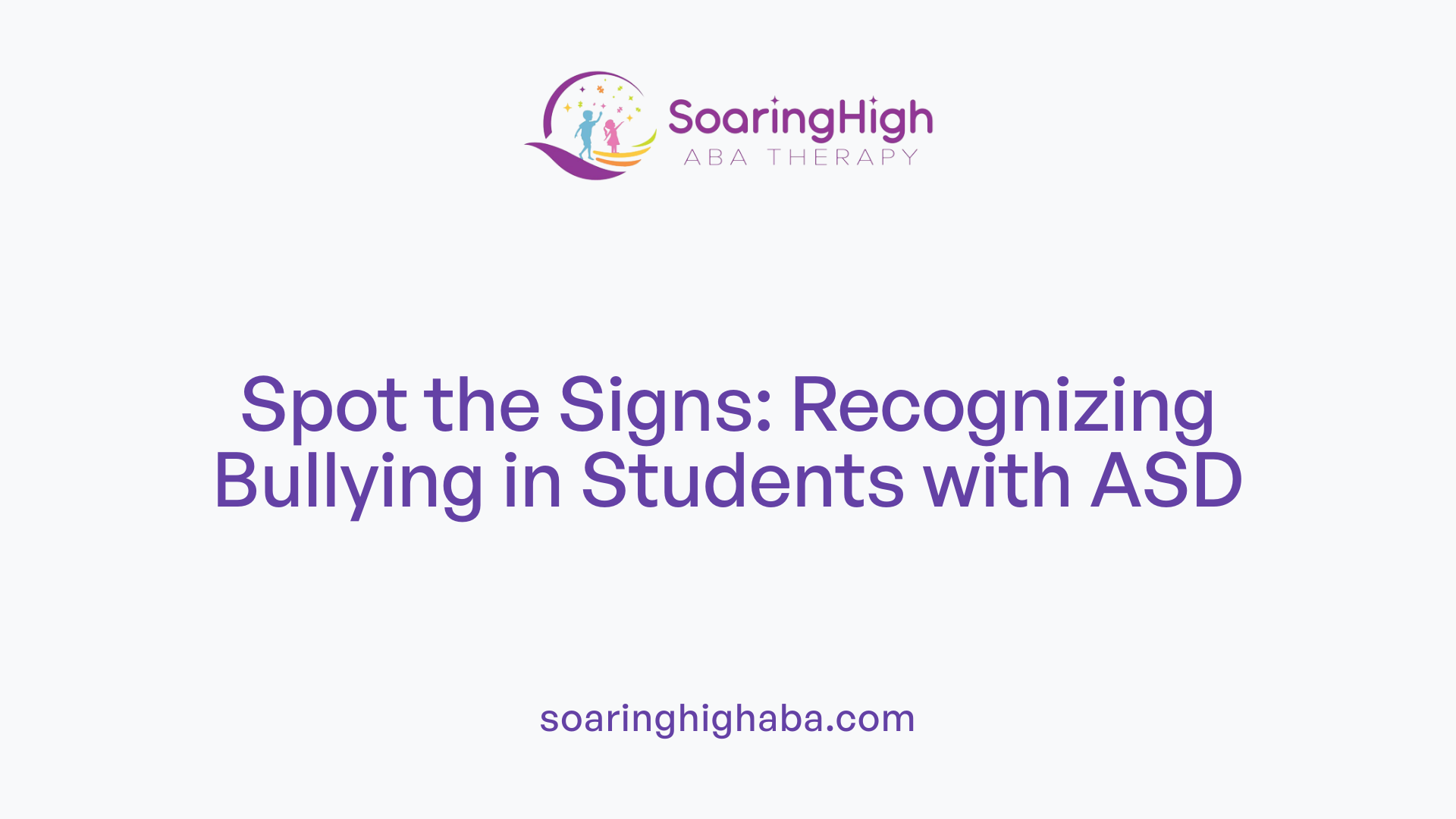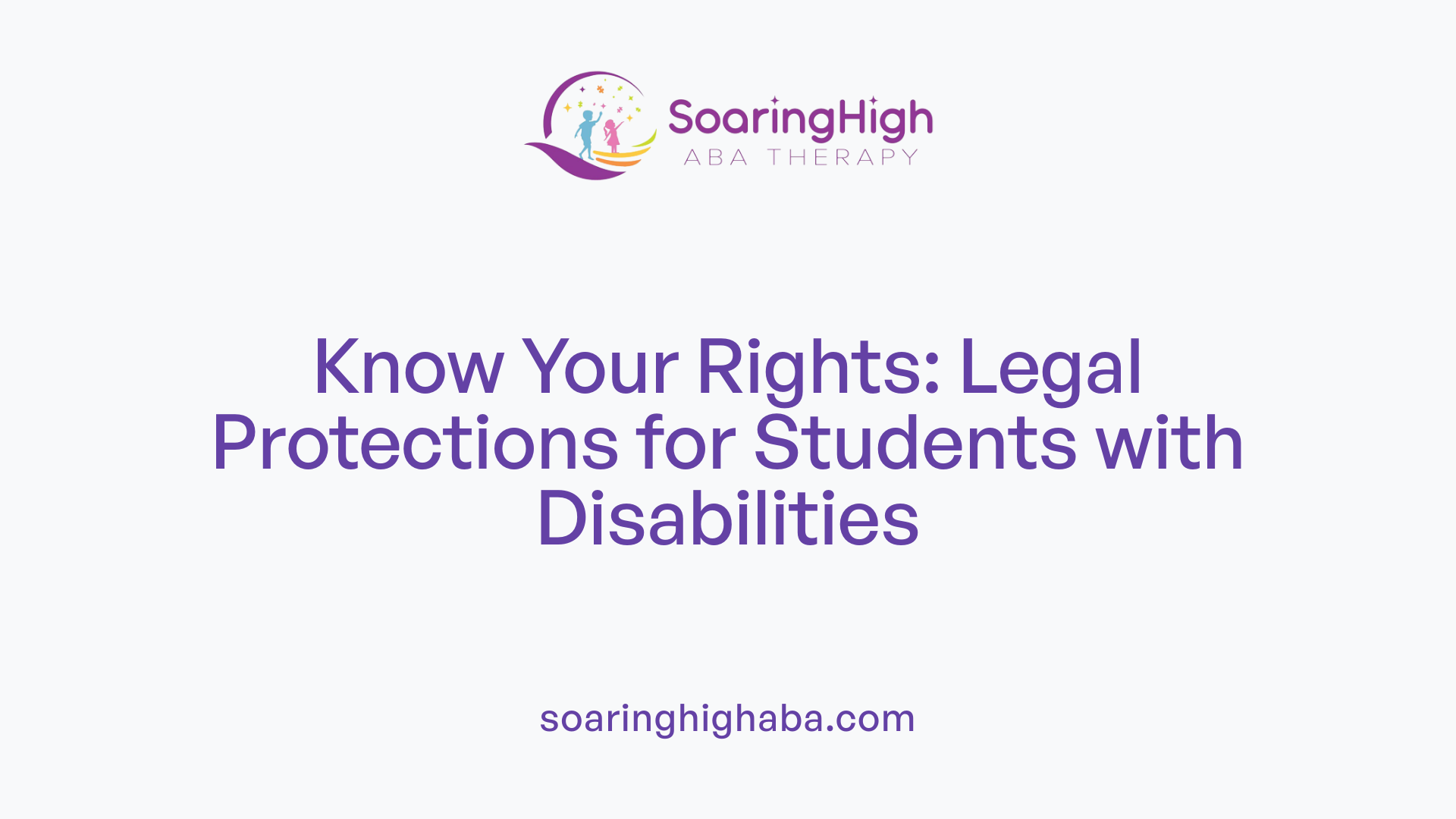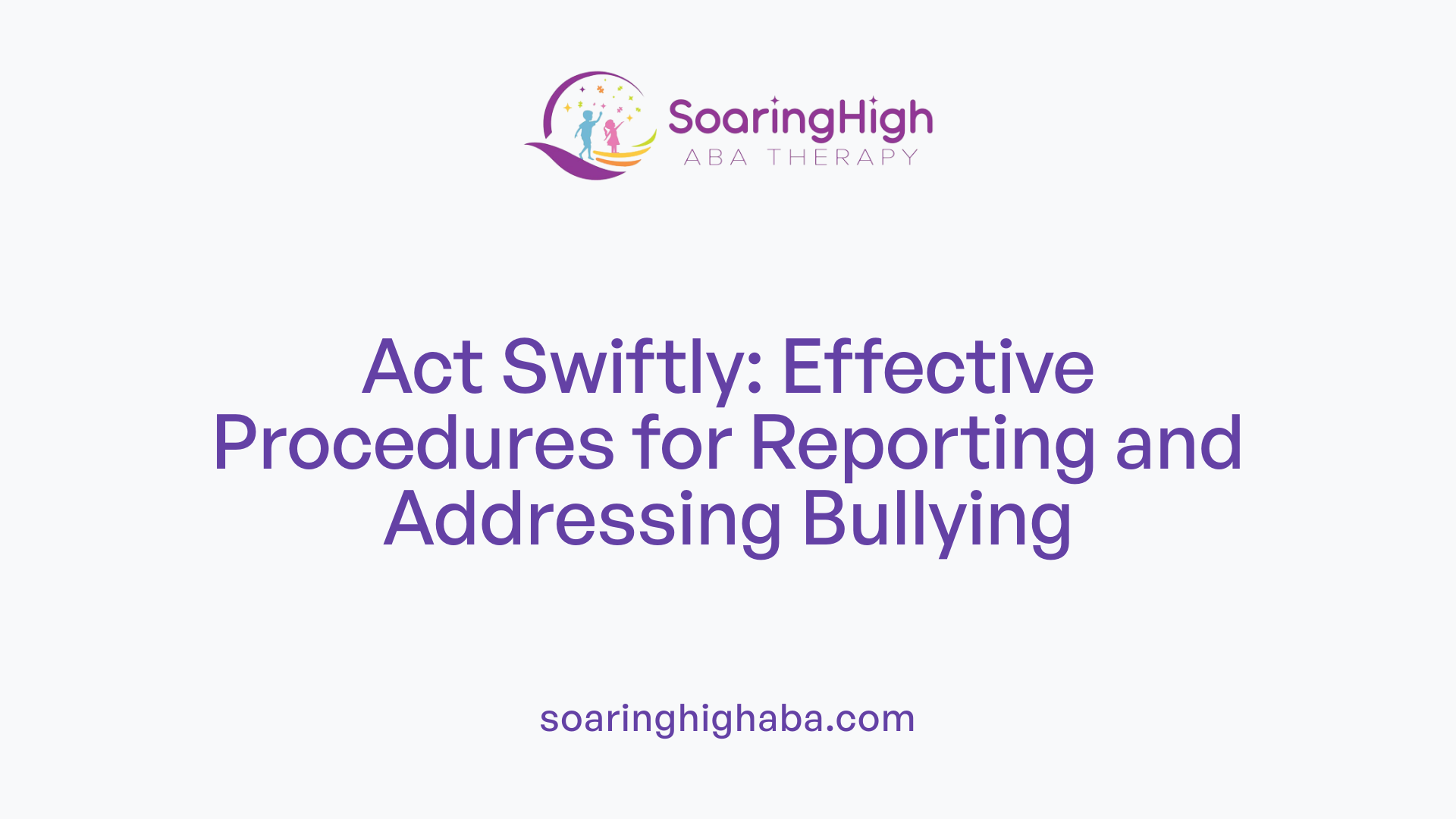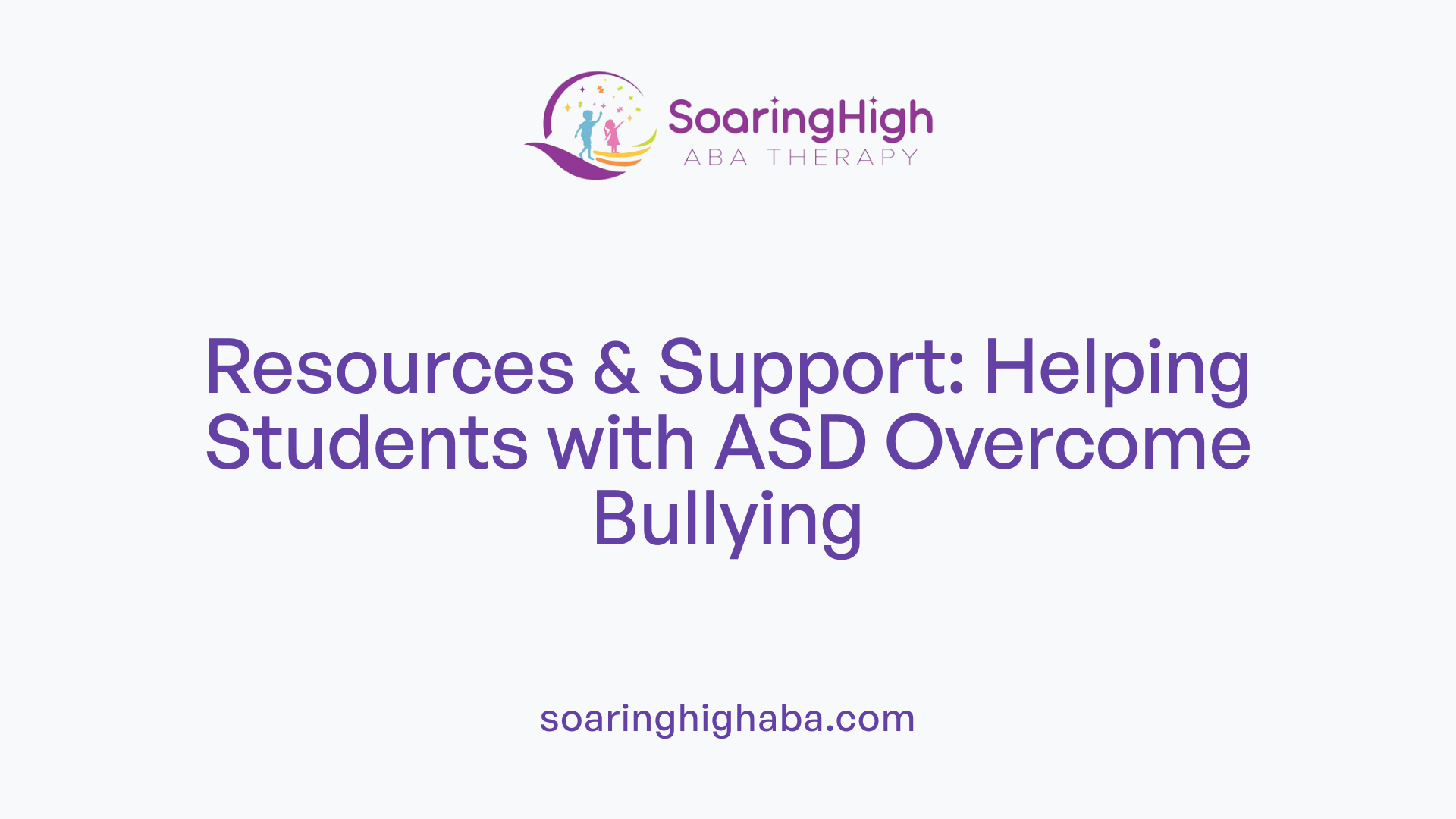Understanding and Addressing Bullying in Students Receiving ABA Therapy
Bullying is a pervasive issue that can have severe mental and physical health consequences for students, especially those with Autism Spectrum Disorder (ASD) receiving Applied Behavior Analysis (ABA) therapy. Recognizing the different forms of bullying, understanding the legal protections in place, and implementing effective prevention and intervention strategies are crucial for parents, educators, and therapists dedicated to fostering safe, inclusive school environments. This article explores comprehensive approaches to addressing bullying concerns, emphasizing legal rights, effective reporting procedures, and best practices within individual education plans (IEPs).
Recognizing and Preventing Bullying in ABA Therapy Contexts

What signs indicate that students with ASD might be experiencing bullying?
Students with Autism Spectrum Disorder (ASD) often exhibit signs that may suggest they are being bullied. Watch for behavioral changes such as withdrawal from social activities, increased anxiety, mood swings, trouble concentrating, or physical symptoms like headaches or stomachaches. Some may become unusually moody, demonstrate low self-esteem, or have difficulty sleeping and eating. Teachers and parents should also observe if the child becomes uncharacteristically aggressive or overly fearful, which can be signs of distress. Early identification of these behaviors can help in addressing bullying promptly.
How can schools develop school-wide policies to prevent bullying?
Effective bullying prevention begins with well-structured, school-wide policies. Schools should create clear, consistent rules that define bullying in all forms — physical, verbal, relational, and electronic. These policies must outline procedures for reporting incidents, investigations, and consequences for violations.
Schools should establish an anti-bullying committee responsible for policy implementation, staff training, and ongoing oversight. Regular awareness campaigns, assemblies, and classroom discussions help reinforce these policies. Incorporating student and parent involvement ensures the policies are understood and supported. Data collection from surveys and incident reports guides continuous improvement, making sure the environment remains safe and inclusive.
What is the role of social skills training and peer programs in prevention?
Social skills training plays a vital role in helping students, especially those with ASD, develop the skills necessary to navigate peer interactions confidently and assertively. Programs that include role-playing, teaching pragmatic language, and practicing non-verbal cues like eye contact help reinforce positive behaviors.
Peer programs, such as buddy systems and peer mentoring, foster inclusivity by encouraging students to support each other and stand against bullying. These programs build empathy, increase peer awareness, and create a buddy network that makes individuals with ASD feel more connected and less vulnerable.
Strategies to recognize, prevent, and respond to bullying involving students receiving ABA therapy
To effectively recognize, prevent, and respond to bullying involving students receiving ABA therapy, schools should adopt a comprehensive approach.
Recognition and Assessment:
- Train staff, students, and parents on identifying signs of bullying.
- Use behavioral observations and communication with the student to detect distress.
Prevention Measures:
- Implement teaching of pro-social behaviors and self-advocacy skills.
- Foster positive relationships through school-wide policies, bullying awareness activities, and involving students in creating a respectful climate.
- Use social skills training and peer programs to teach appropriate social interactions.
Response and Intervention:
- Address reported incidents promptly, privately, and thoroughly.
- Support targeted students with tailored social skills training and emotional support.
- Utilize clear reporting channels, including confidential mechanisms and external professionals.
- Develop individualized intervention plans that include behavioral supports and reinforcement of positive behaviors.
- Engage families and outside resources to reinforce intervention strategies.
Building a Supportive School Culture:
- Promote ongoing education on respect, diversity, and inclusion.
- Consistently enforce anti-bullying policies.
- Recognize and reward positive peer interactions.
By applying these strategies, schools can create a safer, more inclusive environment where students with ASD and under ABA therapy thrive without fear of bullying.
Legal Rights and Protections for Students with Disabilities
 Students with disabilities are safeguarded by several federal laws that aim to ensure their safety and access to quality education free from bullying and harassment. The primary legislation includes the Individuals with Disabilities Education Act (IDEA), Section 504 of the Rehabilitation Act, and the Americans with Disabilities Act (ADA).
Students with disabilities are safeguarded by several federal laws that aim to ensure their safety and access to quality education free from bullying and harassment. The primary legislation includes the Individuals with Disabilities Education Act (IDEA), Section 504 of the Rehabilitation Act, and the Americans with Disabilities Act (ADA).
Under these laws, schools are required to implement policies and procedures designed to prevent bullying and respond appropriately when incidents occur. This includes creating an environment that is safe and inclusive, investigating reports thoroughly, and taking disciplinary or supportive actions as needed.
When bullying, cyberbullying, or disability-based harassment interfere with a student's educational rights or create a hostile environment, families can escalate the issue. They can contact school officials or reach out to the Department of Education's Office for Civil Rights (OCR) or the Civil Rights Division of the Department of Justice (DOJ). These agencies hold schools accountable for addressing harassment and enforcing compliance with federal protections.
In addition, families are encouraged to formally report bullying incidents and request specific interventions, such as updates to Behavior Intervention Plans or accommodations through the student's Individualized Education Program (IEP). Proper documentation and advocacy are essential for ensuring that children receive the necessary support.
Legal protections not only aim to prevent future incidents but also provide avenues for legal recourse if schools do not act promptly or adequately. This includes filing complaints with federal agencies or seeking legal remedies through the courts. Overall, these laws empower families and students with disabilities to advocate for a safe, supportive, and equitable educational environment.
For further information, searching
Effective Reporting and Intervention Processes

What are effective reporting and intervention procedures for addressing bullying incidents involving students with ASD or receiving ABA therapy?
When it comes to supporting students with Autism Spectrum Disorder (ASD) or those engaged in Applied Behavior Analysis (ABA) therapy, schools must implement comprehensive and sensitive procedures to address bullying. These protocols should start with establishing multiple avenues for confidential reporting. Such channels include physical forms, secure online portals, and anonymous systems, making it easier for students, staff, and parents to voice concerns without fear.
Once a report is received, prompt investigation is crucial. School personnel should conduct interviews with the involved students, witnesses, and the reporter, ensuring confidentiality and minimizing further harm. Detailed documentation of all findings, including dates, times, and testimonies, helps in understanding the context and ongoing risks. Immediate safety assessments must be prioritized—schools could create safety plans, designate safe zones, or adjust schedules to protect the student from further harm.
Interventions should be customized to meet each student's specific needs. This includes utilizing evidence-based programs that promote social skills, emotional regulation, and self-advocacy. Behavioral supports like social skills training, peer mentoring, and counseling services can foster resilience and inclusion. Disciplinary actions may be necessary when boundaries are clearly crossed, but the emphasis should be on correcting behavior and restorative practices.
Furthermore, schools need ongoing staff training to recognize signs of bullying and respond effectively. Cultivating a school climate that actively condemns bullying and promotes respect is essential. Involving families and community resources ensures a supportive environment beyond the school, reinforcing prevention and healing efforts.
In summary, effective procedures integrate confidential, multi-channel reporting, thorough investigations, tailored interventions, comprehensive staff education, and community involvement. These steps work together to create safer, more inclusive educational settings for students with ASD or those receiving ABA therapy.
Supportive Resources for Families and Educators

What resources and guidance are available for educators, therapists, and parents to support students with ASD facing bullying?
Parents, teachers, and therapists can access a wide array of resources to help children with Autism Spectrum Disorder (ASD) who experience bullying. Reputable organizations such as PACER’s National Bullying Prevention Center, StopBullying.gov, and the Cyberbullying Research Center offer comprehensive tip sheets, educational materials, and online programs. These resources are designed to promote understanding and provide practical strategies for prevention, intervention, and support tailored specifically to children with disabilities.
School-based bullying prevention programs also serve as vital tools. Programs like the Olweus Bullying Prevention Program, Second Step, and the Bully Free® Program are widely implemented in schools. These curricula include engaging, age-appropriate activities that teach empathy, conflict resolution, and how to stand up safely against bullying. Importantly, these programs often involve parent participation and community engagement, creating a supportive environment for all students.
Legal frameworks further reinforce the protections for students with ASD. Laws such as Section 504 of the Rehabilitation Act and the Americans with Disabilities Act (ADA) require schools to actively prevent discrimination and harassment. These laws also guide schools in developing appropriate accommodations and support systems to safeguard students’ rights.
Effective intervention is most successful when parents, school staff, and mental health professionals work collaboratively. This teamwork can involve developing individualized plans like IEPs (Individualized Education Programs) or 504 Plans that specify the supports needed to prevent bullying and meet each child's unique needs.
Additional strategies include creating inclusive school climates, establishing peer support or buddy systems, and implementing social skills training. These proactive measures foster empathy, respect, and friendship among students, reducing the likelihood of bullying.
In summary, a combination of educational resources, structured prevention programs, legal protections, and collaborative efforts forms a comprehensive approach to supporting children with ASD in facing and overcoming bullying.
Incorporating Anti-Bullying Strategies into IEPs
How can best practices within IEP frameworks address bullying concerns for students with disabilities?
Addressing bullying effectively within an Individualized Education Program (IEP) involves integrating specific strategies that focus on social-emotional growth and safety for students with disabilities, including those with Autism Spectrum Disorder (ASD).
One fundamental approach is to include targeted social-emotional goals and social skills support in the IEP. These goals may focus on enhancing self-advocacy, recognizing stress signals, and practicing calming techniques. Such skills empower students to respond confidently to challenging situations and build resilience.
Behavioral interventions and supports are also critical. The IEP team should develop tailored behavioral plans that include clear expectations for conduct, positive reinforcement, and mechanisms for safe communication and conflict resolution. For example, teaching students scripts (such as the CALM approach: Cool down, Assert yourself, Look them in the eye, Mean it) gives them practical tools to address bullying or social conflicts.
Monitoring and data collection play vital roles in ensuring interventions are effective. Regular observation, incident tracking, and progress evaluations allow educators and families to assess what works and what needs adjustment. This ongoing oversight helps identify patterns and triggers, leading to more responsive strategies.
Best practices within an IEP also emphasize increased adult supervision during unstructured times like recess or lunch, and establishing safe zones or buddy systems. These environmental modifications create a more secure atmosphere, reducing the likelihood of bullying.
Training staff to understand and implement anti-bullying measures consistently is essential. School personnel should be trained in early identification of bullying behaviors, reporting procedures, and intervention techniques to support students adequately.
Collaboration with families, mental health professionals, and community resources ensures a comprehensive support system. Families can provide valuable insights and reinforce social skills and safety plans at home.
Finally, the IEP should align with legal mandates that require schools to provide a harassment-free environment. Incorporating universal bullying prevention education, social skills training, and clear reporting systems within the IEP framework promotes an inclusive and safe educational setting for students with disabilities.
By systematically embedding these strategies into the IEP, schools can proactively address bullying and foster a climate of respect, safety, and support for all students.
Recognizing and Responding to Warning Signs
What types of bullying should be recognized, and what warning signs indicate a student with ASD may be experiencing bullying?
Bullying can take various forms, including physical acts like hitting or shoving, verbal abuse such as name-calling or threats, social exclusion or spreading rumors, and electronic bullying through online platforms or phone messages. Students with Autism Spectrum Disorder (ASD) are particularly vulnerable to these different bullying types because of social communication challenges.
Early identification of bullying involves observing specific behavioral, emotional, and physical signs. Behavioral changes might include withdrawal from social activities, sudden aggression, or excessive clinginess. Emotional signs can manifest as increased anxiety, nightmares, mood swings, or depression. Physically, if a child exhibits unexplained bruises, injuries, or shows a reluctance or fear of going to school, these could be indicators of bullying.
With children with ASD, warning signs also encompass less obvious cues. They may withdraw from usual activities, become more irritable, or display regressive behaviors. Since children with ASD can struggle with recognizing or verbalizing their experiences, they might express distress through tantrums, unusual silence, or increased technology use, such as obsessively checking devices.
It is vital for parents, teachers, and caregivers to maintain open lines of communication with children. Creating a supportive environment where children feel safe to share their feelings is crucial. Educating peers and staff about ASD can foster empathy and reduce instances of bullying.
Implementing safety plans and effective reporting systems is essential. When incidents are suspected or identified, immediate action should be taken by school authorities and mental health professionals to intervene and prevent further harm.
Overall, early recognition of these warning signs allows for prompt intervention. This not only helps to stop ongoing bullying but also supports the emotional and social development of students with ASD, fostering a safer and more inclusive school environment.
Strategies for Students to Respond and Build Resilience
What are effective strategies for students to respond to bullying situations?
Students can adopt several practical and safe strategies when facing bullying. One proven method is the CALM approach, which encourages children to Cool down, Assert themselves, Look the bully in the eyes, and Mean it. This script helps students respond assertively without escalating the situation.
Teaching social skills such as maintaining eye contact, using clear and confident language, and practicing role-play scenarios can prepare students to handle bullying effectively. It’s crucial that students understand responding with violence or retaliation can worsen the situation.
Seeking help from trusted adults like teachers, counselors, or parents is vital. Students should be encouraged to report any cyberbullying to the platform involved, such as Instagram or TikTok, so abusive behavior can be removed or addressed. Documenting incidents—screenshots, dates, descriptions—helps create a record that can be used for reporting and intervention.
Building confidence is another protective measure. Engaging in extracurricular activities, social skills training, and fostering friendships provide emotional support and resilience. Supportive peer groups and mentors contribute to a sense of safety and belonging.
It's also important for children to understand that bullying is not their fault. Parents and educators should reinforce this message and support mental health services if students experience anxiety, depression, or low self-esteem. Bystanders play a critical role by encouraging peers to intervene safely or by reporting bullying incidents.
Creating a respectful school environment involves comprehensive education, clear policies, and active enforcement. When students and adults work together—reporting incidents, practicing assertiveness, and promoting kindness—the overall climate becomes safer for everyone.
Fostering a Culture of Safety and Respect
Community-wide strategies are essential to create a school environment where all students, including those with Autism Spectrum Disorder (ASD), feel safe and respected. Schools should develop comprehensive policies that involve teachers, staff, students, families, and community organizations to promote inclusivity and prevent bullying.
An effective response to bullying incidents involving students with ASD must be proactive and systematic. Educators and therapists should adopt a broad approach, implementing prevention programs that emphasize positive behavior, social-emotional learning, and conflict resolution. School-wide initiatives can include classroom activities that teach empathy, understanding differences, and appropriate ways to handle disagreements.
Part of a strong anti-bullying strategy involves regular staff training to increase awareness of ASD-related issues and appropriate intervention techniques. Establishing confidential reporting systems allows students and staff to report bullying incidents safely and without fear of reprisals. School counselors can work closely with teachers, families, and community partners to develop tailored support plans for students impacted by bullying.
Targeted interventions like the STAC (Smile, Tell, Act, and Care) program train students to become defenders, empowering peers to stand against bullying. Such programs not only reduce victimization but also foster a culture of kindness and peer support.
Addressing systemic barriers is vital. This includes ensuring consistent adult supervision in common areas, especially near bathrooms, locker rooms, and playgrounds, where bullying might be more prevalent. Schools should identify and monitor “hot spots” and implement proactive strategies such as increased supervision and social skills training in these areas.
Supporting students with ASD extends beyond the school environment. Connecting students to outside resources, including mental health counseling and social skills groups, helps them develop resilience, empathy, and emotional regulation skills.
Ultimately, building trusting relationships, promoting understanding of neurodiversity, and engaging the entire school community in anti-bullying efforts are essential. These collective actions foster a respectful culture that protects vulnerable students, encourages positive interactions, and ensures every child’s right to a safe learning space.
Building a Positive and Inclusive Educational Environment
Addressing bullying among students receiving ABA therapy requires a multifaceted approach that combines legal awareness, proactive prevention, swift response, and ongoing support. Schools need to develop clear policies aligned with federal protections, train staff and students, and implement tailored strategies within IEP frameworks. Creating a culture of respect and inclusion, backed by community involvement and resources, is essential for safeguarding students’ well-being. By fostering open communication, empowering students with self-advocacy skills, and ensuring diligent monitoring, educators and families can work together to build safe, nurturing environments where every student feels valued and protected.
References
- Get Help Now | StopBullying.gov
- Bullying for Mental Health Professionals | Fact Sheet - ABCT
- Yes! Bullying Can Be Addressed through the IEP
- StopBullying.gov
- Preventing and Addressing Bullying - ASAT Online
- Recognize, Respond, Report: Preventing and Addressing Bullying ...
- How Can I Help My Child Deal With Bullying At School?
- Students with Disabilities and Bullying - PACER Center





































































































